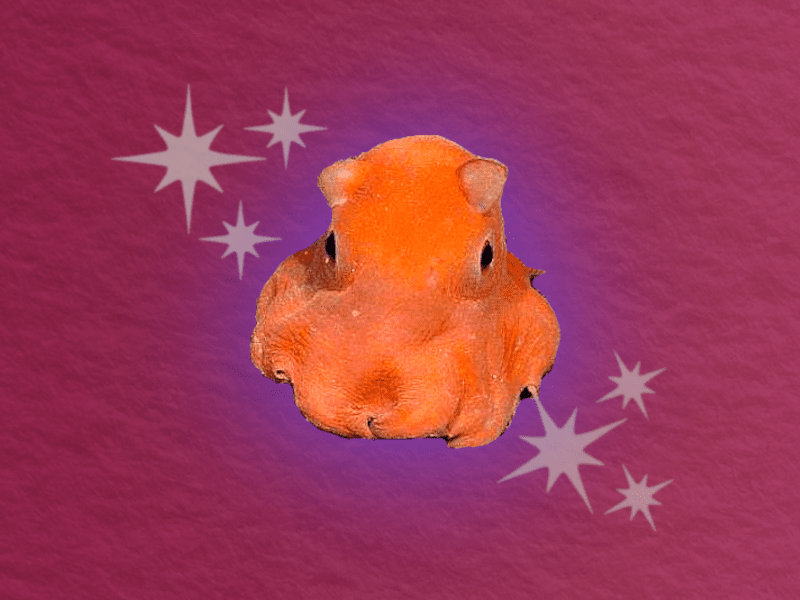What Do You Call A Tiny Octopus That’s Cute As A Button?

JOHANNA: We are back with another round of Diction Dash.
[ELECTRONIC AND STACCATO DICTION DASH SONG BEGINS]
JOHANNA: Where I try (and usually fail) to guess to guess the origin or true meaning of a word. This week, we're talking cephalopods. Octopuses, cuttlefish, squid, all of those clever often-tentacled marine invertebrates. Quizzing me today is Diana Montano, trivia master at Science Friday. Hey Diana.
DIANA: Hello!
JOHANNA: So if you have heard Diction Dash before you know my track record leaves much to be desired. So this time I have called in reinforcements. Here to help me maybe possibly actually get a question correct for once is Ira Flatow, host of Science Friday. Hello and thank you, Ira.
IRA: Ah, such a burden you have put on my shoulders but happy to be of service.
DIANA: All right. So I am going to read both of you a question and give you a few answer choices. You two will put your heads together and give me your final answer. If you get it right, you'll hear this sound. [DINGING BELL SOUND] And if you're wrong, I don't think it’ll happen, but if you're wrong, you'll hear this sound. [FOG HORN SOUND] Alright, are you two ready?
JOHANNA: Ready.
IRA: Ok let’s… dive in.
JOHANNA: [Groans] Ira…
IRA: Sorry.
JOHANNA: I’m Johanna Mayer and this is Diction Dash.
DIANA: Alright, so here's question one. What do you call a tiny octopus with big eyes, flappy little ear-like fins, and that's cute as a button? In 2015, Stephanie Bush and her team at the Monterey Bay Aquarium Research Institute, were tasked to classify and name this newly caught and previously undescribed deep sea cephalopod. I need to know what name did they end up naming the species. So remember, this is a story from 2015. And it's either A.) Californiana, for where it's collected and described. B.) Lacina, after the Latin word for flap. C.) Adorabilis, because it's just so dang cute. Or D.) Stephania after Dr. Bush herself, who helped collect it.
JOHANNA: I actually know this one!
IRA: This was so cute we could not not know this one.
JOHANNA: I know I’m actually gonna demand that we see a photo of this next time. It’s C, Adorabilis, right Ira?
IRA: Adora-absolutely-adorabilis. C, final answer.
[FOG HORN SOUND]
JOHANNA: What?! No!
IRA: No.
DIANA: The correct answer is A, Californiana.
JOHANNA: No it’s not! That’s not—
IRA: No… Can’t be.
DIANA: So, here, here, let me tell you the full story. Alright, so we're not exactly sure why they didn't end up going with adorabilis. But if you've seen the Science Friday video, this is what they thought they were going to call it. But I guess not everyone in the scientific community thinks this creature is as lovable as the rest of us.
IRA: Don’t you feel cheated on that?
JOHANNA: I feel so cheated.
IRA: I thought we had a lock on that.
JOHANNA: I’m gonna continue to call it Adorabilis.
IRA: Yea, me too.
DIANA: You should! Well, so you two probably knows some of this but we have Carl Linnaeus to thank for our binomial or two-word naming system, where basically just say the genus and species to refer to a specific animal, plant or other living thing. These days, the International Code of Zoological Nomenclature is used by biologists to name species. And so there are 18 chapters to this code. There are 90 articles... So there's a lot of, lot of rules and apparently picking the cutest name is not one of those rules.
IRA: Find me the rule for the appeals process on this.
JOHANNA: Yeah, I will sign the petition.
IRA: Now I know how Pluto felt.
JOHANNA: We are not off to a great start with this, Ira.
DIANA: Alright, are you guys ready for question 2?
IRA: Question 2, go for it.
JOHANNA: Redeem ourselves….
IRA: Yeah.
DIANA: The origins of the word “ink” go way back. Originally, the word was enca. It was a shortening from the Latin encaustum. So special inks have special names like sacrum encaustum, which was a purple red ink used by the Roman emperors to sign their important decrees. And it's actually made from shellfish. But they're not the only invertebrates that were used for inks. What color is named after the pigment collected from the ink sac of a common cuttlefish? Is it A.) sepia B.) aquamarine C.) fuchsia, or D.) ombre.
JOHANNA: What color is ombre again? Is that like a gray-ish?
DIANA: It's kind of like a like a yellowy brown.
IRA: Gee. I don’t know this at all. What color… Well, what do you think Johanna?
JOHANNA: As usual, I'm sort of at a loss but I kind of have a hunch that it's sepia.
IRA: Ok, I’ll go with you on sepia.
JOHANNA: Why not. We have no better guess.
IRA: Why not. Yeah.
JOHANNA: Okay, final answer A.) sepia.
[BELL DINGS]
DIANA: Hey!
JOHANNA AND IRA: Yay!
IRA: Got one!
JOHANNA: We’re one and one!
DIANA: That is the correct answer, congratulations!
IRA: Just like on my SATs. This is how I did it.
JOHANNA: You just guessed?!
DIANA: One on, one off.
IRA: That’s it.
DIANA: So, sepia ink was pretty commonly used for writing, drawing and any other of your penned needs in Greco Roman civilization for over the- about two millennia ago. Eventually, it was used in the 19th century to help warm up black and white photographs and help preserve the image longer. So that's why we use a sepia filter on Instagram. But you can also thank cephalopods for those old but still recognizable photographs of your great great ancestors.
IRA: Pretty cool.
JOHANNA: Alright, our last question, let’s hear it Diana.
DIANA: I need you both to picture the biggest organism that you can think of. Alright, in your mind's eye. Are you picturing it?
IRA: Yes.
JOHANNA: Uh, yeah.
DIANA: Okay, so tell me are you shivering in the Arctic? Or maybe you're wearing sunglasses in a sandy desert? Where are you right now? Ira, where are you picturing the largest organism?
IRA: I’m underground.
DIANA: Oh, interesting.
JOHANNA: Yeah I was gonna say I think I’m in a forest.
IRA: Yea, exactly. I think we’re in the same spot—hey! I can see you there!
JOHANNA: Oh hey Ira!
DIANA: Well, I hope that you're picturing yourself surrounded by white bark and yellow leafed aspens in the hills of Utah, because technically Pando, a clonal colony of identical aspens is considered a single thing, a single living thing. And therefore the world's most massive organism.
JOHANNA: Oh wow. Yea I think I’ve actually heard of this—it’s got like one giant interconnected root system right?
DIANA: Yes, it's essentially one tree. All these trees have the same DNA. And so they are one they're considered a clonal colony, quote, unquote, and it's just one identical aspen all the way as far as the eye can see.
JOHANNA: Is that where you were picturing Ira?
IRA: No, I wasn’t.
JOHANNA: Me neither!
IRA: I was picturing a giant fungus.
JOHANNA: Me too! I thought we were on a giant, giant mushroom.
IRA: Yeah.
DIANA: You know, I have in parentheses here. There's also a gigantic fungus that was discovered in Oregon that some say is actually larger than Pando, but either way, I'm just very glad that we're talking about plants.
IRA: We have stumped the stumper!
JOHANNA: My, how the tables have turned.
DIANA: It may not sound very impressive. For instance, to me Pando the name, sounds like a Roly Poly friendly Panda, but names can be deceiving. Which of the following is the largest squid species in terms of mass on Earth? Alright, in terms of mass. Is it A.) the giant squid, B.) the colossal squid, C.) the jumbo squid, or D.), the robust club hook squid?
JOHANNA: Are these all real names? They sound like jokes.
IRA: Yeah.
JOHANNA: The humongous squid and then the super duper humongous squid.
DIANA: These are all real. They're all real squid, but one of them is the largest in terms of mass.
IRA: When you say largest Do you mean the size of the individual squid or in total around the world there are more of them?
JOHANNA: Good question.
DIANA: A wonderful question. I mean an individual, what is the largest individual squid and what is that species. We're talking about if you weighed a bunch of different squids, would the colossal, the giant, the jumbo or the robust clubhook, squid be the largest. Which of those species?
IRA: Well, I mean because they named it the colossal they want us to think that’s probably the biggest squid.
JOHANNA: I dunno Ira, what’s bigger: colossal or jumbo?
IRA: Good question.
DIANA: It’s so subjective!
IRA: In popcorn boxes I think jumbo is bigger than colossal. But I don’t know.
JOHANNA: I don’t think it’s giant, right?
IRA: You know, have you heard of any of these squid before?
JOHANNA: I’ve only heard of the giant squid.
IRA: Well, that's what I'm thinking, maybe we should go with giant. At least we know we've heard of it.
JOHANNA: Yeah. Diana did say that she did not make up any of these. But I agree, I remain suspicious of the jumbo squid.
DIANA: Alright I’m gonna need a final answer from you all.
IRA: I’ll go with the giant.
JOHANNA: I agree, I think we should cling to familiarity here. Let’s go with the giant squid. Final answer.
[FOG HORN SOUND]
JOHANNA: Nooo.
IRA: Ooooh. I'm sorry to tell you that the correct answer is B.) colossal squid. The largest known complete specimen of the colossal squid was a mature female squid captured in February 2007 in the Ross Sea. It's an extremely cold body of water in the Southern Ocean that encircles Antarctica. And it was estimated to weigh about 990 pounds, and it measured between 26 and 33 feet. And for those visual listeners out there, that is at least 4.5 Iras tall.
IRA: At least.
JOHANNA: How many Johannas?
DIANA: Probably five, I'd say.
JOHANNA: Wait, what is the okay so colossal has - has the most mass? What, going down from there? Is it then the jumbo and then the giant and then the robust?
DIANA: I believe it was the giant, then jumbo, then robust clubhook, yeah.
JOHANNA: I think we over-thought that one, Ira.
IRA: Maybe I was thinking of jumbo shrimp and I should’ve been thinking of…
JOHANNA: Colossal shrimp.
IRA: Colossal shrimp. Well, I don't think I don't think Wait Wait is gonna get us on their show anytime soon.
JOHANNA: Yeah, keep your day job Ira. And I will too.
IRA: Right exactly.
JOHANNA: This has been embarrassing.
DIANA: But a lot of fun, I think we can agree on that. So, thank you both. This was amazing.
IRA: Thank you. Thanks for having me.
JOHANNA: Thank you Diana. Thanks Ira.
[DICTION DASH SONG]
JOHANNA: If you want to learn even more about cephalopods, you are in luck. Cephalopod Week is an annual extravaganza here at Science Friday and there's a ton of stuff happening. We're gonna get behind the scenes at the Monterey Bay Aquarium, play some more deep sea trivia, watch some mini documentaries, so much more. You can find out about all of that at sciencefriday.com/squid.
[DICTION DASH SONG RESTARTS]
JOHANNA: This episode of Science Diction was produced by me with Diana Montano and Katie Feather. Elah Feder is our senior producer. Daniel Peterschmidt composed all our music and they mastered this episode. Nadja Oertelt is our Chief Content Officer. See ya soon, squid-heads.
